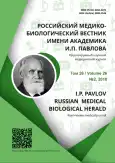Angiotensins in the central mechanisms of drinking instrumental activity of rats with different manifestations of risk behavior
- Authors: Vlasenko R.Y.1, Kotov A.V.2
-
Affiliations:
- Novgorod State University named after Yaroslav the Wise
- Scientific Research Institute of Normal Physiology named after P.K. Anokhin
- Issue: Vol 26, No 2 (2018)
- Pages: 222-228
- Section: Original study
- URL: https://journals.rcsi.science/pavlovj/article/view/9094
- DOI: https://doi.org/10.23888/PAVLOVJ2018262222-228
- ID: 9094
Cite item
Abstract
Aim. To carry out a comparative analysis of characteristics of drinking instrumental activity in rats with different manifestation of risk behavior before and after intracerebral introduction of equally productive dipsogenic doses of angiotensins.
Materials and Мethods. The work was conducted on 19 Wistar male rats of 250300 g mass. All manipulations with animals were performed in accordance with the international ethic recommendations on biomedical research with use of animals. All rats were preliminarily scalped under ether anesthesia with removal of soft tissues and periosteum. The cannulae were introduced into rat’s brain through the trephine opening in the lateral ventricle. The length of each cannula was 8 mm, the internal diameter – 0.8 mm. All cannulae had a special restrictor at the distance of about 3.5 mm from the implantable end. Each animal was implanted one cannula into the lateral ventricle of the brain on the right or left side according to the coordinates of stereotaxic atlas for rats (L.D. Pellegrino at al., 1979) (AP = +1.0; L= 2; H= 2.5). Microinjections of substances were made into the brain of nonnarcotized animals using a microsyringe of 5 μL volume («Hamilton», the USA). For intraventricular microinjections, angiotensinII, angiotensinIII and [des – Asp1]angiotensinI («Sigma», the USA) were used.
Results. In the article the mechanisms of realization of drinking instrumental activity in rats with different manifestations of risk behavior are described. In view of P.K. Anokhin’s general theory of functional systems, the effects of application of «equally productive» doses of angiotensins on initiation of specific patterns of drinking behavior in rats are discussed. Risk is considered as an independent component of systemic organization of purposive behavior of an individual. It is shown that the «integral pattern of individual behavior» of rats is selectively modulated by angiotensinII and angiotensinIII. This selectivity has a narrow focus and individual manifestations, depending on the background activity of the animals.
Conclusion. Depending on the initial level of the intensity of instrumental activity of the animals (with different manifestations of risk behavior), angiotensin II and angiotensin III are involved into initiation of fullscale «integral pattern of individual drinking behavior» or participate in the directed modulation of complex purposive behavior manifested by enhancement of dipsogenic effect. At the same time, [des – Asp1]angiotensinI does not participate in the mechanisms of reproduction of the acquired drinking instrumental habits but induces only mechanisms of initiation of congenital individual forms of drinking behavior.
Keywords
Full Text
##article.viewOnOriginalSite##About the authors
Roman Ya. Vlasenko
Novgorod State University named after Yaroslav the Wise
Author for correspondence.
Email: romex@mail.ru
ORCID iD: 0000-0002-7328-0520
SPIN-code: 9013-1219
MD, PhD, Associate Professor, Department of Normal Physiology, Institute of Medical Education
Russian Federation, 41, St.Petersburgskaya street, Veliky Novgorod, 173003Alexander V. Kotov
Scientific Research Institute of Normal Physiology named after P.K. Anokhin
Email: romex@mail.ru
ORCID iD: 0000-0002-1810-7741
SPIN-code: 2749-4037
MD, Grand PhD, Professor, Head of the Laboratory of Physiology of Motivation
Russian Federation, P.O.B. 72, Moscow, 125315References
- Аnokhin PK. Biologiya i nejrofiziologiya uslovnogo refleksa. Moscow: Meditsina; 1968. (In Russ).
- Matvienko YI. Sovremennye podkhody k izucheniyu riska. Izvestiya Tul'skogo gosudarstvennogo universiteta. 2012;1:16573. (In Russ).
- Diev VS. Filosofskaya paradigma riska. EHKO. Ekonomika i organizatsiya promyshlennogo proizvodstva. 2008;12:2738. (In Russ).
- Il'in EP. Psikhologiya riska. Saint Petersburg: Piter; 2012. (In Russ).
- Vlasenko RYa. Risk kak samostoyatel'nyj komponent sistemnoj organizatsii tselenapravlennoj deyatel'nosti sub»ekta. IP Pavlov Medical Biological Herald. 2014;22(2):14653. (In Russ).
- Al'gin AP. Risk i ego rol' v obshchestvennoj zhizni. Moscow: Mysl'; 1989. (In Russ).
- Kornilova TV. Psihologiya riska i prinyatiya reshenij: uchebnoe posobie dlya vuzov. Moscow: Aspekt Press; 2003. (In Russ).
- Vlasenko RYa., Kotov АV. Sravnitel'nyj analiz motivatsiogennoj aktivnosti angiotenzinov u krys v ehksperimente. Zhurnal Vysshej Nervnoj Deyatel'nosti imeni I.P. Pavlova. 2003;53(1):1136. (In Russ).
- Аnokhin PK. Izbrannye trudy. Sistemnye mekhanizmy vysshej nervnoj deyatel'nosti. Moscow: Nauka; 1979. (In Russ).
- Ukhtomskij АА. Dominanta. Saint Petersburg: Piter; 2002. (In Russ).
Supplementary files








